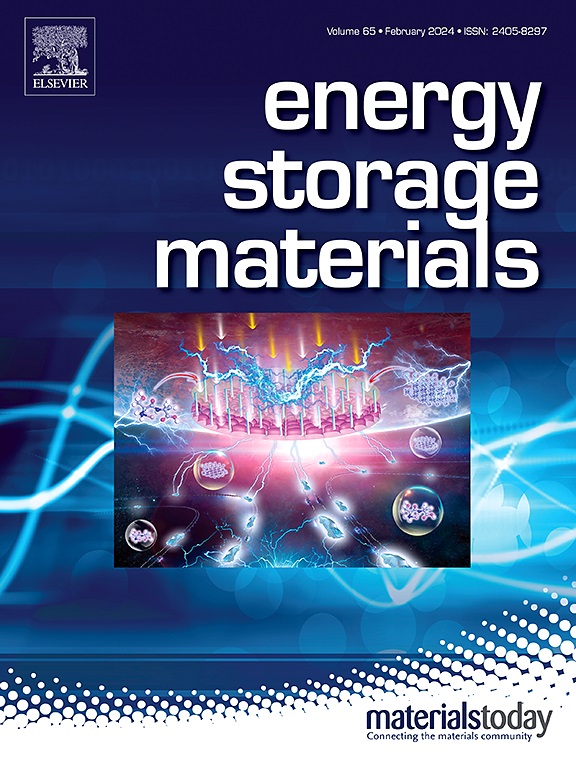高压LiCoO2用有机硅添加剂的分子极性和位阻设计
IF 20.2
1区 材料科学
Q1 CHEMISTRY, PHYSICAL
引用次数: 0
摘要
高压LiCoO2 (LCO)具有高容量,但存在严重的电解质分解和寄生反应。阴极电解质界面相(CEI)具有保护阴极界面和增强界面稳定性的作用。然而,在基于lipf6的电解质中,不可避免的酸性物质如HF会腐蚀CEI,进一步促进副反应。总的来说,有机硅添加剂不仅可以捕获酸性物质,还可以参与CEI的形成。在这里,我们报道了一种通过调整苯基和甲氧基结构来优化分子极性和位阻效应的有机硅设计。所设计的三甲氧基苯基硅烷(TRSE)具有出色的HF捕获能力、LCO表面趋近能力和阴离子结合能力,可有效抑制界面副反应,有助于先进的CEI构建,提高高电压下的循环稳定性。因此,在限制hf的电解液环境下,以及富集了LiF和Si-F成分的CEI显著提高了容量保持率(在1℃下循环100次后提高~ 32%)和倍率性能(在10℃时提高~ 80 mAh/g,而在10℃时提高~ 10 mAh/g)。该研究为高压LCO电池的先进电解质添加剂设计提供了基础见解。本文章由计算机程序翻译,如有差异,请以英文原文为准。


Molecule polarity and steric hindrance design to nominate organosilicon additive for high-voltage LiCoO2
High-voltage LiCoO2 (LCO) exhibits high capacity but suffers severe electrolyte decomposition and parasitic reactions. The cathode electrolyte interphase (CEI) is supposed to protect the cathode interface and enhance interfacial stability. However, in LiPF6-based electrolytes, unavoidable acidic species like HF could corrode CEI, further facilitating side reactions. In general, organosilicon additives could not only capture acidic species but also participate in CEI formation. Here, we report an organosilicon design on optimizing molecular polarity and steric hindrance effect by tuning the phenyls and methoxy configuration. The designed Trimethoxyphenylsilane (TRSE) displays outstanding HF capture, LCO surface approaching tendency as well as anions binding ability, which could effectively suppress interfacial side reactions and assist advanced CEI construction to enhance the cycling stability at high voltage. As a result, the HF-limited electrolyte circumstances and the CEI with LiF and Si-F ingredients enrichment dramatically enhance capacity retention (∼32 % higher after 100 cycles at 1 C) and rate performance (∼80 mAh/g vs. ∼10 mAh/g at 10 C). This study offers fundamental insights into the advanced electrolyte additives design for high-voltage LCO batteries.
求助全文
通过发布文献求助,成功后即可免费获取论文全文。
去求助
来源期刊

Energy Storage Materials
Materials Science-General Materials Science
CiteScore
33.00
自引率
5.90%
发文量
652
审稿时长
27 days
期刊介绍:
Energy Storage Materials is a global interdisciplinary journal dedicated to sharing scientific and technological advancements in materials and devices for advanced energy storage and related energy conversion, such as in metal-O2 batteries. The journal features comprehensive research articles, including full papers and short communications, as well as authoritative feature articles and reviews by leading experts in the field.
Energy Storage Materials covers a wide range of topics, including the synthesis, fabrication, structure, properties, performance, and technological applications of energy storage materials. Additionally, the journal explores strategies, policies, and developments in the field of energy storage materials and devices for sustainable energy.
Published papers are selected based on their scientific and technological significance, their ability to provide valuable new knowledge, and their relevance to the international research community.
 求助内容:
求助内容: 应助结果提醒方式:
应助结果提醒方式:


